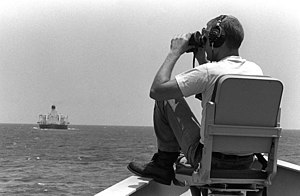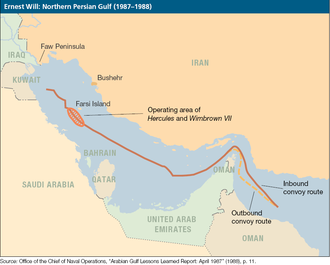Operation Earnest Will
| date | July 24, 1987 - September 26, 1988 |
|---|---|
| place | Persian Gulf |
| output | Maintaining oil supplies to the western world |
| Parties to the conflict | |
|---|---|
| Troop strength | |
| 1 aircraft carrier 4 destroyers 1 cruiser 3 frigates 1 amphibious transport dock |
4 frigates 4 gunboats |
Iraqi Invasion (1980)
Entegham - Kaman 99 - Khorramshahr - Sultan 10 - Scorch Sword - Abadan - Kafka - Ashkan - Morwarid - Dezful
Standoff (1981) Tavakol - Susangerd - H-3
Iranian offensives for the liberation of Iranian territory (1981–82)
Sam-ol-A'emeh - Tariq al-Qods - Fath ol-Mobin - Beit ol-Moqaddas - liberation of Khorramshahr
Iranian offensives in Iraq (1982–84)
Ramadan - Muslim Ibn Aqil - Muharram ol-Harram - Dawn 1 - Dawn 2 - Dawn 3 - Dawn 4 - Dawn 5 - Kheibar - Kurdish Uprising - Dawn 6 - Dawn 7 - Hawizeh Marshland
Iranian offensives in Iraq (1985-87)
Badr - Dawn 8 - 1. al-Faw - Dawn 9 - Karbala 1 - Karbala 2 - Karbala 3 - Fath 1 - Karbala 4 - Karbala 5 - Karbala 6 - Karbala 7 - Karbala 8 - Karbala 9 - Karbala10 - Nasr 4
Last year of the war (1988)
Beit ol-Moqaddas 2 - Anfal - Halabdscha - Zafar 7 - Tawakalna ala Allah - 2nd al-Faw - Shining Sun - 40 stars - Mersad
Tanker War
Earnest Will - Prime Chance - Eager Glacier - Nimble Archer - Praying Mantis
International Incidents
USS Stark - Iran Air Flight 655
The Operation Earnest Will (dt about. Sincere desire ) was a military operation forces of the United States to protect Kuwaiti oil tankers against Iranian attacks in the Persian Gulf during the Tanker War in the first Gulf War . The operation ran from July 24, 1987 to September 26, 1988 and was planned and carried out by the United States Central Command (CENTCOM) under General George B. Crist . In addition to marine units, which served to directly protect the tankers, helicopters and reconnaissance aircraft from other branches of the armed forces were also tasked with investigating the Iranian action.
history
background
During the war, from 1981 onwards, both Iran and Iraq repeatedly attacked tankers and cargo ships from the other side in order to prevent imports and exports and thereby weaken the enemy. In 1984 both states signed a UN moratorium that ruled out shooting at civilian targets. After Iraq broke the agreement a short time later, Iran resumed attacks. On November 1, 1986, Kuwait officially asked for help as ships flying the Kuwaiti flag, similar to that of Saudi Arabia , were the most frequently attacked. The Soviet Union responded in early 1987 by announcing that it would charter Soviet tankers to transport oil. Thereupon the USA offered on March 7th to let eleven Kuwaiti tankers drive under the stars and stripes (see also the trade flag ). This enabled the United States Navy to escort the tankers ; any attack on tankers would be counted as an attack on the United States. Kuwait accepted this offer. After Iraq attacked the frigate USS Stark on May 17 and excused this as a "pilot's mistake", the US accused Iran - not involved in the incident - of escalating the conflict and dispatched warships to the region.
surgery
The escort trips began on July 22, 1987. In addition to warships, AWACS surveillance aircraft of the US Air Force and helicopters of the US Army operated reconnaissance.
Already on the first voyage, the MV Bridgeton (named under the Kuwaiti flag as al-Rekkah ) ran into a sea mine , but the double-hulled ship was able to continue its voyage. The escorts, three thin-walled US warships without substantial protection against sea mines, now followed in the wake of the tanker. Large-scale attacks on the tankers subsided in the weeks that followed, as Iran apparently wanted to avoid a direct confrontation with the United States. After the incident, the US Navy towed three minesweepers into the Gulf, and they also used helicopters for mine clearance . In addition, the navies of Great Britain ( Royal Navy ), Belgium ( Belgian Navy ), the Netherlands ( Dutch Navy ), France ( French Navy ) and Italy ( Marina Militare ) deployed deminers in the Gulf. This was done at the request of the USA. After the countries initially hesitated to allow themselves to be drawn into the conflict, they decided to participate in the mine clearance when a freighter sailing under the Panamanian, i.e. neutral flag, ran into mines in the Gulf of Oman .
As part of the parallel but secret Operation Prime Chance (August 1987 to June 1989), special forces were brought into the region for reconnaissance, including the 160th Special Operations Aviation Regiment (Airborne) , which flew reconnaissance missions with Hughes MH-6 Little Birds . Heavily armed helicopters of the type AH-6 Little Birds were also parked to protect the deminers. The US Army helicopters were stationed on Navy ships and briefed on their targets by the Navy Sikorsky SH-60 Seahawk . Two barges were later rented from the Kuwait Oil Tanker Company to serve as a base for the army aviators. On October 8, 1987, an AH-6 helicopter sank an Iranian Boghammer speedboat .
The next wave of attacks began on October 15, 1987, when a Chinese-made Iranian anti-ship missile Silkworm hit the flagged supertanker Sea Isle City at an oil terminal outside Kuwait City and wounded 18 sailors, including the U.S. captain . As a result, the four destroyers USS John Young , USS Hoel , USS Kidd and USS Leftwich launched an attack on two Iranian oil platforms in the Rostam oil field on October 19, 1987 in Operation Nimble Archer (Eng .: nimble archer ) . At 1.40 p.m., a warning was sent to the platforms that an attack would begin 20 minutes later. At 2 p.m., two ships each attacked a platform with their 5-inch guns, one completely destroyed and the other 90% destroyed. A SEAL team placed explosives on one of the platforms and destroyed it.
While the attacks on tankers from neutral nations continued, albeit on a reduced scale, Operation Earnest Will halted the attacks on the flagged tankers. In 1988 the situation in the Gulf became more and more tense; eight local and ten international navies were now operating there. After the USS Samuel B. Roberts ran into a mine on April 18, 1988 after a convoy voyage back to Bahrain (with 69 seamen injured), the Iranian Navy was involved in Operation Praying Mantis by the US Navy in a one-day sea battle beaten.
In this mounting tension, the American warship USS Vincennes accidentally shot down an Iranian civil Airbus A300 , killing 290 people.
The last escort mission took place on September 26, 1988 by the USS Vandegrift .
consequences
Military
Operation Earnest Will was the US Navy's largest convoy operation since the Second World War, with a total of 259 ships escorted in 127 convoys. The company made it possible to maintain oil supplies to the western world during a dispute in which, according to Lloyd's, 546 civilian ships were damaged and approximately 430 civilian seamen were killed. Ultimately, the operation also marked the first deployment of American units in the Gulf and showed the US's interest in the oil-rich region.
Operation Earnest Will was the first cross-armed deployment of the Special Operations Forces of the US Special Operations Command (SOCOM) established on April 16, 1987 , which temporarily subordinated parts of its Navy SEALs, Special Boat Teams and SOAR airmen to the CENTCOM. This support made a significant contribution to achieving the control over the northern Persian Gulf and the successful fight against Iranian mine-layers and micro surface units and resulted in the following years means for the procurement of new weapons systems, such as patrol boats of the Cyclone-class and multi-purpose boats of the type Mark V Special Operations Craft were approved.
Politically
In 1992 Iran filed a complaint with the International Court of Justice in The Hague , which denied the attacks on the oil platforms under Operation Nimble Archer (as well as under the later Operation Praying Mantis ) as part of the 1955 Treaty of Amity, Economic Relations and Consular between the parties Rights between the United States of America and Iran (German: Agreement on friendly and economic relations and consular rights between the United States of America and Iran ) should clarify. The associated procedure ran under the name Oil Platforms (Islamic Republic of Iran v. United States of America) .
On November 6, 2003, the International Court of Justice ruled on the legality of the attacks. It was decided with 14: 2 votes that the operation was not necessary for the safeguarding of the essential security interests of the United States according to Article XX, paragraph 1 (d) of the agreement. This paragraph only allows acts of war for direct self-defense interests. However, since it had not been clearly proven that the missile launched against Sea Isle City could be attributed to Iran, the judges denied any need for self-defense . Despite this, Iran's claim for reparations payments was rejected as the operation did not constitute a breach of the obligation to free trade between the parties' territories under Article X, paragraph 1. This was justified by the fact that the platforms were being repaired at the time of the operation and therefore were not producing any oil that could have been sold to the US. A counterclaim by the USA, which demanded compensation for attacks on tankers according to this article, was rejected by 15: 1 votes. The reason was that none of the ships were trading between Iran and the United States. The fundamental objection of the USA that Iran makes shipping in the Gulf unsafe was not recognized either.
literature
- Peter Huchthausen: America's Splendid Little Wars: A Short History of US Engagements from the Fall of Saigon to Baghdad . New York 2004: Penguin. ISBN 0-14-200465-0 .
- Michael Palmer: On Course to Desert Storm . Honolulu 2003: University Press of the Pacific. ISBN 1-4102-0495-2 .
- Harold Lee Wise: Inside the Danger Zone: The US Military in the Persian Gulf 1987-88 . Annapolis 2007: Naval Institute Press. ISBN 1-59114-970-3 .
- David B. Crist: Joint Special Operations in Support of Earnest Will . In: Joint force quarterly . Autumn / Winter, 2002, ISSN 1070-0692 , p. 15–22 ( oai.dtic.mil [accessed January 27, 2012]).
Web links
- Operation Earnest Will on globalsecurity.org (English)
- Photos of operation on the pages of the book No higher honor (English)
- International Court of Justice ruling on the unlawfulness of the attacks and a summary from The Daily Star ( Memento of November 17, 2004 in the Internet Archive )




